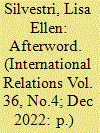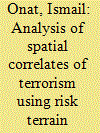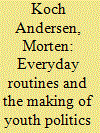| Srl | Item |
| 1 |
ID:
188930


|
|
|
|
|
| Summary/Abstract |
How should we think about war today? This afterword assesses the impact of using a temporal lens to understand contemporary conflict. Reflecting upon my own work on media and war alongside wider societal relationships to violence, I consider the ways in which new technologies and styles of warfighting change both our view of time and our understanding of war itself. In particular, I show how a shift from space to time helps focus attention on the personal and lived experience of US war, on the importance of routines both in constituting and obscuring wartime, on how many issues of contemporary war have become a matter of digitized perspective, and finally how emergent technologies have unsettled familiar temporal patterns of conflict. War today is media-drenched but struggles to occupy our attention over sustained periods. It remains an epochal political force that we tend to approach through deeply individualized, microcosmic stories. It proceeds at breakneck pace but rarely gets anywhere. These questions and tensions underline the importance of focusing not only on the resolutely temporal aspects of wartime, but also on the way in which shifts in time are changing the very nature and politics of war in the 21st century.
|
|
|
|
|
|
|
|
|
|
|
|
|
|
|
|
| 2 |
ID:
166663


|
|
|
|
|
| Summary/Abstract |
The purpose of this study is to identify correlates of terrorism in space. It examines whether places with terrorist incidents show similar patterns with respect to the physical features across landscape, and tests the spatial influence of various features of environment on the incidence of terrorism. Drawing on the locations of violent terrorist offenses committed between 2008 and 2012, the study in Istanbul applies the Risk Terrain Modeling framework to terrorism. It uses data on police incidents and infrastructure (e.g., government buildings or parks). The analysis employs GIS techniques and an event count model, and combines all risky layers in a composite map to understand where the risk is higher. The study suggests a concentration of 1153 violent terrorist incidents relative to key physical factors by identifying seventeen potential risk factors, eight of which were significantly correlated in the model. Regardless of terrorists’ intent, the significantly associated establishments increase the risk in the surrounding areas where these features are located. The coexistence of leisure places such as bakeries, religious facilities, or eateries results in higher risks. While the environmental backcloth may constitute a risk for terrorism, its components may also help forecast the locations of terrorist incidents in the future.
|
|
|
|
|
|
|
|
|
|
|
|
|
|
|
|
| 3 |
ID:
168567


|
|
|
|
|
| Summary/Abstract |
This article illustrates some of the practices that turn young student men into political activists. It shows how everyday routine practices bring order and meaning to a social field of hierarchical competition and conflict amongst young men at Dhaka University. The focus is on those practices that make and shape the organisations everyday, involving and bringing people together in a collective of activism and exclude others. Routines continuously reconstruct relations of hierarchy, organisational order and operation, which on one hand, transform individuals from students into activists, on the other hand, it produces structured hierarchies and operational logics. It makes activism and shapes organisations. The article concludes that a focus on the internal dynamics of mobilising organisations, mundane intimate interactions and the display of public practices, can pay dividends when it comes to a deeper understanding of the formation of political activism.
|
|
|
|
|
|
|
|
|
|
|
|
|
|
|
|